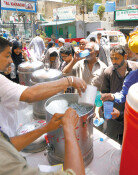A Season of Typhoon
More typhoons are expected this year than ever before. According to Korea Meteorological Administration (KMA), super typhoons like Rammasun, the fifth of the year, are likely to take place and many of them to pass over the Korean peninsula.
As severe damages from typhoons are expected, the government is required to make a thorough preparation against disasters.
▽Causes
KMA said on July 7 that of more than 10 strong typhoons like Rammasun occurring this summer, at least one or two would have direct impact on Korea
Previously, typhoons taking place at this time of season headed for China. But a phenomenon that an exceptionally strong typhoon like Rammasun headed north up to the Korean peninsula in early July is because the seawater temperature of the tropical West Pacific area, where typhoons occur, reaches 29° to 31°, 1° ~ 3° higher than usual.
KMA explained that this year, a warm ocean current concentrated in one place while cold and warm seawaters were circulating ceaselessly, pushing up the seawater temperature of the West Pacific area.
Besides, North Pacific high pressure concentrated near the equator, supplying warm airs to the tropical West Pacific. As a result, the temperature in the area was increased.
▽Abnormal Weather Conditions?
The weather forecasting agency said that the phenomenon of more frequent typhoons than usual, which is caused by the increase in the sea level temperature, also happened many times in the past, so that it is hard to consider it as an abnormal weather condition.
In addition, as an El-Nino condition is in its initial stage, it could not be linked to this weather phenomenon.
Currently, no one exactly knows effects of environmental changes in earth systems like air pollution or ozone destruction.
▽Forecast
As of July 7, typhoon Chataan with central air pressure of 945hPa and central wind velocity of 45m per second, which is stronger than Rammasun, is heading north from the eastern Philippine sea.
The sixth typhoon is likely to approach up to the sea off Okinawa, Japan in the morning of July 9. The agencies concerned are on alert because if it stays in the current course, it would move in the same direction as Rammasun.
From 1971 to 2000, 27 typhoons on average took place in the tropical West Pacific area annually. But this year, more typhoons will occur, said one official of KMA.
In addition, as the seawater temperature is far higher than 26°, at which typhoons used to start occurring, a great deal of the water vapor, their energy source, is highly like to evaporate and flex its strong muscle.
KMA said that the high water temperature in the area is expected to continue until September.
Typhoon is 10,000 times as strong as the atomic bomb dropped in Nagasaki, Japan, in 1945, said Park Jung-kyu, a section chief of KMA. Thorough preparations against typhoons should be made especially in places and facilities vulnerable to landslides or floods.
Ho-Gab Lee gdt@donga.com







